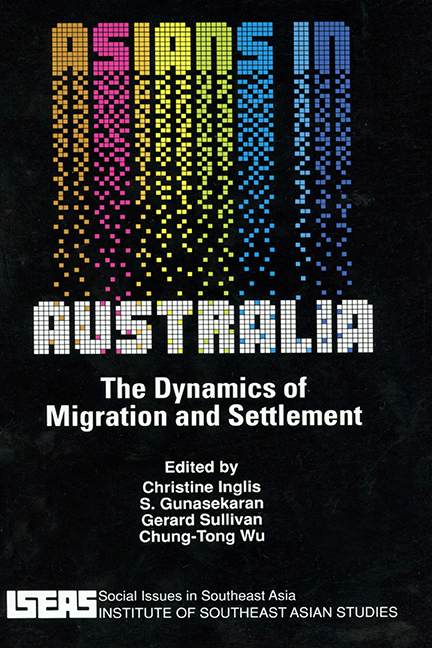Book contents
- Frontmatter
- Contents
- List of Tables
- List of Figures
- Introduction
- 1 China's Policy Towards Migrants, 1842–1949
- 2 Japanese Emigration Policy, 1880–1941
- 3 The “New” Migration and Australian Immigration Policy
- 4 Patterns of Settlement in Australia of Indochinese Refugees
- 5 Labour Market Outcomes Among the Chinese at the 1986 Census
- 6 Is There An Asian-Australian “Brain Drain”?
- 7 The “New” Migration of Asian Skills and Capital to Australia
5 - Labour Market Outcomes Among the Chinese at the 1986 Census
Published online by Cambridge University Press: 21 October 2015
- Frontmatter
- Contents
- List of Tables
- List of Figures
- Introduction
- 1 China's Policy Towards Migrants, 1842–1949
- 2 Japanese Emigration Policy, 1880–1941
- 3 The “New” Migration and Australian Immigration Policy
- 4 Patterns of Settlement in Australia of Indochinese Refugees
- 5 Labour Market Outcomes Among the Chinese at the 1986 Census
- 6 Is There An Asian-Australian “Brain Drain”?
- 7 The “New” Migration of Asian Skills and Capital to Australia
Summary
For more than a quarter of a century, Australian social scientists have lamented the deficiencies of country of birth as an index of ethnic origin. National boundaries do not always coincide with the historical, geographical, and cultural bonds that unite groups with a common ancestry. Even if they once did, wars and political realignments can sever the nexus. Partly in response to these concerns, and partly to the growing importance of multiculturalism, the 1986 census of Australia broke new ground by including a question on ancestry. Together with information on birthplace, birthplace of parents, religion, and language spoken at home, these ancestry data throw new light on the ethnic composition of the Australian population.
For some immigrant groups, such as the Italians, ancestry data provide little additional information beyond conventional birthplace data. Most immigrant Australians of Italian ancestry were born in Italy, although some came from Egypt and Malta as well. However, other groups like the Chinese cannot be easily identified from birthplace figures, because they originate from different overseas countries, in many of which they were an ethnic minority. To identify such groups, ancestry data are needed. Ancestry data also permit the identification of third-generation members of different immigrant stock, that is to say, the ethnic origins of persons born in Australia of Australian-born parents. This chapter discusses an analytic strategy for comparing labour market outcomes among different immigrant generations, focusing on persons of Chinese ancestry.
Theory and Analytic Approach
Economists and sociologists have advanced two types of theories for understanding how immigrants (and women) fare in labour markets. The first type stems from neo-classical theories of human capital and examines the international transferability of training and experience. The second derives from status attainment models that explore how social background and early socialization affects achievement. Both theories usually consider the issue of how far discrimination affects socio-economic outcomes.
- Type
- Chapter
- Information
- Asians in AustraliaThe Dynamic of Migration and Settlement, pp. 117 - 156Publisher: ISEAS–Yusof Ishak InstitutePrint publication year: 1992

